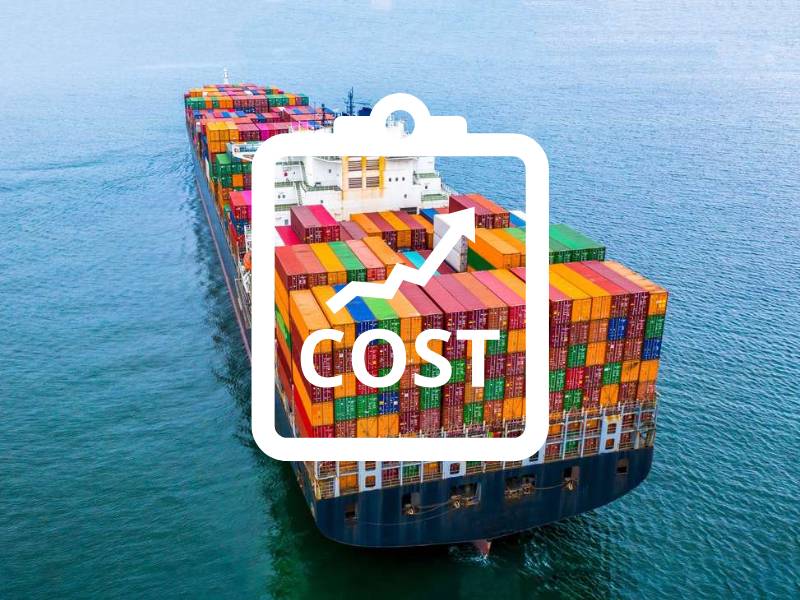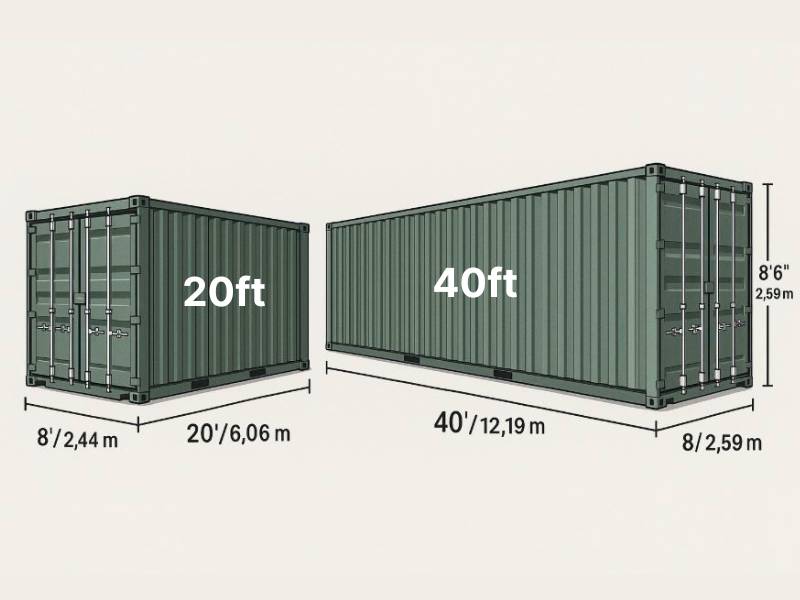In recent years, global sea freight has undergone unprecedented volatility and transformation due to various factors such as politics, changing trade policies, and supply chain disruptions. Vietnam, as a rapidly growing manufacturing and export hub, offers competitive production costs and a robust logistics infrastructure to global traders.
This article explores the key factors affecting the sea freight cost from Vietnam, and provides a detailed look at the costs and cost structures for different methods of shipping.
What is sea freight cost?

Sea freight cost is the total cost incurred in the process of transporting goods by sea from the point of origin (usually a seaport in the exporting country) to the destination (a seaport in the importing country). This is an important part of the international supply chain and directly affects product prices, business competitiveness, as well as the decision to choose the shipping method of exporters and importers.
Ocean freight costs include not only the cost of renting a ship or container, but also many other fees related to cargo handling, insurance, customs procedures, and additional charges arising from market conditions or international regulations.
Most popular sea freight methods
Full Container Load (FCL)
This is a method where the supplier will fill the entire space in a standard container (20-foot or 40-foot) and pay a fixed price. FCL is often preferred for large shipments, with many advantages such as:
- Lower sea freight cost for large shipments.
- Reduced risk of damage because the goods are packed into the container at once.
- Direct shipping, saving time.
The disadvantages of FCL are higher fixed costs for small shipments, and the need for larger storage space.
Less than Container Load (LCL)
This method allows multiple shippers to share space in a container. Each one pays only for the space occupied, saving costs for small shipments. Advantages of LCL include:
- Lower entry costs for small volumes.
- Flexibility for mixed shipments.
- No need to wait for enough orders to fill the container.
However, LCL has the disadvantages of higher sea freight cost per CBM and longer transit times due to additional stops.
Typical sea freight cost from Vietnam
FCL container (40ft)
| Destination | Estimated cost (USD) | Notes |
| Australia (Sydney) | ~$2200 | Competitive rate for Asia-Pacific region |
| United States (Los Angeles) | ~$3000- ~$4500 | Varies by port and season
|
| Canada (Vancouver/Toronto) | ~$5000- ~$6500 | Higher during peak seasons
|
| United Kingdom (London) | ~$4000- ~$5500 | Influenced by EU-Vietnam trade agreements |
| Germany (Hamburg) | ~$4500- ~$600 | Common route for electronics and textiles |
LCL cost
General range $200–$1,000 per cubic meter
Average shipment: ~$1,600 for small loads : Ideal for businesses shipping smaller quantities or samples.
Key factors affecting sea freight cost
a. Origin and destination ports
Geographical distance: Longer routes typically cost more. For example, from Vietnam to the East Coast of Canada.
Port infrastructure: Modern ports such as Cai Mep and Cat Lai often offer better prices due to economies of scale.
Destination charges: Some Australian ports such as Sydney and Melbourne impose higher charges.
b. Container size and type

20-foot vs. 40-foot containers: 20-foot containers are suitable for volumes of around 28 CBM, while 40-foot containers go up to 60 CBM. Although the price per CBM for a 40-foot container is lower, the absolute total cost is higher.
Special Containers (Reefer, Open Top): These containers may have a surcharge of 30–100% for reefer or hazardous cargo.
c. Seasonality and Peak Season Surcharges
Peak Season Surcharges (PSS): Applies during Asia’s main export seasons (August–October). PSS can range from $350–$1,500 per container and can increase during geopolitical disruptions.
d. Market Volatility and General Price Increases (GRIs)
Supply-Demand Imbalance: Increased demand (due to post-pandemic recovery or vessel shortages) can push prices up. Conversely, a surplus of vessels can reduce prices.
GRIs: Carriers often announce price increases. For example, EPP Vietnam has seen fluctuations of around $500–$1,500 in the last few months of 2025 when exporting jumbo bags.
e. Geopolitical and Economic Instability
Red Sea and Middle East Region: Diversions to avoid conflict increase shipping times and costs. Surcharges can range from $1,000–$4,000 per container.
Taxes and Trade Agreements: The US-Vietnam Trade Agreement imposes a 20% tax on most exports to the US.
Additional Surcharges Affecting sea freight cost
1. Port Handling Fees
These fees include:
- B/L Fees: $45–$60 per set.
- Telex Issuance Fees: $30–$40 per B/L.
- Documentation/Administrative Fees: $35–$55 per B/L.
- Container Cleaning Fees: $16–$25 per container.
- Container Imbalance Fees: $50–$130 for 20’ containers; $100–$230 for 40’ containers.
2. Fuel Surcharges (Bunker Adjustment Factor BAF)
BAF is charged to offset fluctuations in marine fuel prices. It can represent 15–25% of the total base shipping cost and can increase by $300–$600 per 40’ container due to disruptions in the oil market.
3. Peak and Emergency Charges
Peak Season Surcharge (PSS): $350–$1,500 per container during periods of high demand.
War Risk Surcharge and Congestion Charge: $1,000–$4,000 per container on specified routes.
4. Cargo Insurance Costs
Cargo insurance is not mandatory but is recommended, typically 0.2–0.5% of the declared value of the cargo.
5. Import duties and import fees
Australia: Imports are generally subject to 0–5% duty, with a 10% GST on goods over $1,000 AUD.
Canada: Most Vietnamese goods enjoy a 0% duty under CPTPP and a 5% GST.

6. Detention, detention and storage fees
Detention fees: Charged if a container stays too long at the port ($18–$40 per day for a 20’ container).
Detention and storage fees: Charged for late return of empty containers and port storage fees.
Questions related to ocean freight
How to calculate CBM in ocean freight?
CBM (cubic meter) is calculated by the formula:
CBM=width x length x height
For example: A package is 1.2m long, 0.8m wide, 0.6m high, then CBM = 1.2 × 0.8 × 0.6 = 0.576 CBM
What is the difference between a 20ft and a 40ft container?
A 40ft container has almost double the capacity of a 20ft but does not cost twice as much. If there are many goods, 40ft container will be more economical.
How much is the ocean freight cost per kg?
Sea freight cost is usually calculated by CBM or equivalent weight, with prices ranging from 0.5 USD to 2 USD/kg.
How to calculate the total sea freight cost?
The total cost includes freight, port handling fee, document fee, cargo insurance, taxes and fuel surcharges.
Example: Send 2 CBM of goods to Australia by LCL:
– Freight: 2 × 300 USD = 600 USD
– Terminal Handling Charge: 100 USD
– Documentation fee: 50 USD
– Insurance: 30 USD
→ Total cost: about 780 USD
This article has provided an insight into the factors that affect the sea freight cost from Vietnam to markets. Price fluctuations and geopolitical and economic factors not only impact shipping strategies but also require shippers to be more flexible and proactive in planning. Understanding additional costs and optimizing the shipping process will help businesses better control costs and ensure efficiency in export operations. With the current challenges, applying smart strategies and establishing close relationships with logistics partners will be the key to success in this field.

